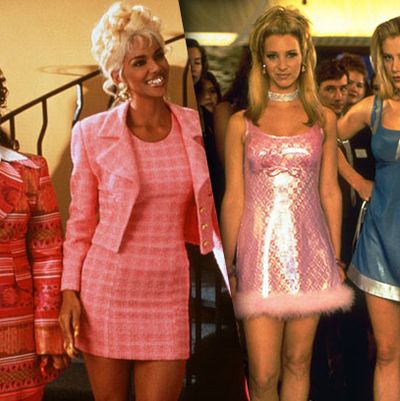
The venerable movie genre known as the buddy comedy, which hit its stride in the eighties with the likes of 48 Hrs., Running Scared, and┬áMidnight Run, is in no danger of extinction, at least not as long as Jonah Hill and Seth Rogen are working. But even now, in 2013,┬áThe Heat, with its two female leads (Sandra Bullock and Melissa McCarthy), stands out like Joe Pesci on the Lethal Weapon 3 movie poster. Perhaps it should come as no surprise that Hollywood still has trouble generating female-led movies; thereÔÇÖs an entire website dedicated to tracking movies in which two female characters even talk to each other,┬áa task so seemingly basic that youÔÇÖll be shocked how few movies meet it. But still, itÔÇÖs more than a little disheartening that, since the eighties, fewer than ten buddy comedies starring two women have been released. Fewer than ten!
What makes this statistic even more glaring is how promising things once seemed for the female buddy comedy genre. The hilarious 1987 movie Outrageous Fortune, pairing Bette Midler and a Cheers-departing Shelley Long, was a solid hit generating $52.8 million (more than $100 million when adjusted for inflation), just over $3 million more than a much more famous buddy comedy from that year, Planes, Trains, and Automobiles. The next year, Midler would team up with Lily Tomlin for Big Business, in which they played buddies twice over (two sets of twins!), and the movie pulled in $40.1 million (approximately $77 million adjusted), or $2 million more than Midnight Run, the Robert De NiroÔÇôCharles Grodin comedy that is often held up as being a highlight of the genre.
Sadly, Hollywood didnÔÇÖt get the message. The next decade had plenty of high-profile buddy comedies ÔÇö Twins, Dumb and Dumber, and┬áMen in Black,┬áto name just a few ÔÇö but virtually none starring two famous women. Even if you count 1992ÔÇÖs┬áDeath Becomes Her, which some would say passes the criteria for inclusion in the genre by the barest of margins (Meryl Streep and Goldie Hawn had an in-his-prime Bruce Willis to contend with), it wasnÔÇÖt until 1997, when Mira Sorvino and Lisa Kudrow starred in Romy & MichelleÔÇÖs High School Reunion, that another out-and-out female-led buddy comedy arrived. The film was a modest hit, generating $29.2 million in theaters and plenty more as a cult comedy on home video, but even profit didnÔÇÖt encourage Hollywood to make more movies like it.
From 1997 on, the female-led buddy comedy saw its nadir. YouÔÇÖd have to go into contortions to justify some films that qualify; 1997ÔÇÖs B.A.P.S., for example, is technically┬áa buddy comedy, even though most buddy comedies have two famous stars above the title and B.A.P.S. can only boast Halle Berry. But one thing that canÔÇÖt be questioned is how poorly most of them did at the box office. B.A.P.S. made $7.2 million that year; two years later, Kirsten Dunst and Michelle Williams starred in Dick, a critically acclaimed comedy that nevertheless pulled in a meager $6.2 million. In 2002, Susan Sarandon and Goldie Hawn toplined The Banger Sisters, which generated a soft $30.3 million, while in 2006, Salma Hayek and Pen├®lope Cruz put out their action comedy Bandidas ÔǪ and couldnÔÇÖt even score a U.S. release. Occasionally, Hollywood issues a variation on the buddy comedy that stars┬ámore than two women, such as┬áFirst Wives Club and Sex and the City ÔÇö but, amazingly, even those have been few and far between.
ItÔÇÖs not until more recently that the female buddy comedy genre has started to show signs of life again. The first encouraging women-led buddy comedy in years was 2008ÔÇÖs Baby Mama, which paired Tina Fey and Amy Poehler; despite an unglamorous release by Universal that April, the film made a pretty terrific $60.4 million. For perspective, Baby Mama came out the same day and went on to handily outgross the second Harold and Kumar film, which made only $38.1 million, a series-high number for the franchise. And yet weÔÇÖve gotten three Harold and Kumar movies but only one Baby Mama.
And that brings us to The Heat. ItÔÇÖs encouraging that 20th Century Fox had enough confidence in the film to move it up from its original April 5 slot to this weekendÔÇÖs much more competitive summer berth. But will its status as a blockbuster-to-be lead to more female-driven buddy comedies? LetÔÇÖs hope so ÔÇö weÔÇÖre still hoping to see that sex comedy starring Natalie Portman and Anne Hathaway we were promised back in 2010. Still, given the genreÔÇÖs track record, donÔÇÖt be surprised if HollywoodÔÇÖs response to a successful Bullock-McCarthy team-up is blustery immediate talk of doing a sequel, followed by years of further hot air about doing a sequel, followed by absolutely nothing.

